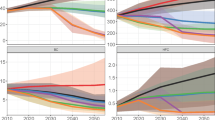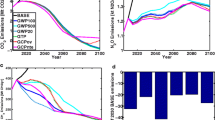Abstract
In climate policy, substitutions metrics are used to determine exchange ratios for different greenhouse gases as part of a multi-gas strategy. The suitability of the metric depends on the policy goals and considerations regarding its practical use. Here, we present a multi-model comparison study to look at the impact of different metrics on the mitigation strategies and global climate policy costs. The study looks into different Global Warming Potentials (GWP) and the Global Temperature change Potential (GTP). The study shows that for all the models, varying between GWPs - from different IPCC reports, with different integration periods: 20 or 100 years - has a relatively small influence on policy costs (< 2.2 % spread across scenarios with a 2.8 W/m2 target) and climate outcomes. Metrics with a constant low substitution value for methane (effectively reducing its abatement), in contrast, lead to higher-cost mitigation pathways (with an average cost increase of 32.8 % in a 2.8 W/m2 scenario). If implemented efficiently, a time-varying GTP leads to a limited cost reduction compared to GWP. However, under imperfect foresight in combination with inertia of CH4 abatement options, or if implemented sub-optimally, time-varying GTP can result in higher costs than a 100-year GWP. At the same time, given a long-term radiative forcing target, a time-varying GTP results in slightly higher maximum global temperature change rates.




Similar content being viewed by others
Notes
For the radiative forcing target the so-called “AN3A” metric was used to generate results comparable to the widely used Representative Concentration Pathways (RCPs) (van Vuuren et al. 2011). This metric includes all anthropogenic forcing agents except direct forcing from land albedo changes, mineral dust and nitrate aerosols. This means that the total radiative forcing target is +/− 0.2 W/m2 higher.
References
Den Elzen MGJ et al. (2007) Multi-gas emission envelopes to meet greenhouse gas concentration targets: costs versus certainty of limiting temperature increase. Glob Environ Chang 17:260–280
Deuber et al. (2013) Physico-economic evaluation of climate metrics: a conceptual framework. Environ Sci Pol 29:37–45
Ekholm et al. (2013) Robustness of climate metrics under climate policy ambiguity. Environ Sci Pol 31:44–52
Fuglestvedt et al. (2003) Metrics of climate change: assessing radiative forcing and emission indices. Clim Chang 58:267–331
IPCC (1990) Climate change: the intergovernmental panel on climate change scientific assessment. Cambridge University Press, Cambridge
IPCC (2001) TAR WG1, climate change 2001: the scientific basis, contribution of working group I to the third assessment report of the intergovernmental panel on climate change. Cambridge University Press, Cambridge
IPCC (2009) Meeting report of the expert meeting on the science of alternative metrics. Plattner G-K, Stocker TF, Midgley P et al (eds). IPCC WGI Technical Support Unit, Bern, Switzerland, pp75
Johansson (2011) Economics- and physical-based metrics for comparing greenhouse gases. Clim Chang 110:123–141
Johansson et al. (2006) The cost of using global warming potentials: analysing the trade off between CO2, CH4 and N2O. Clim Chang 77:291–309
Kandlikar M (1995) The relative role of trace gas emissions in greenhouse abatement policies. Energy Policy 23:879–883
Kriegler D. et al. (2014) Making or breaking climate targets: the AMPERE study on staged accession scenarios for climate policy. Technological Forecasting and Social Change.
Lucas D et al. (2007) Long-term reduction potential of non-CO2 greenhouse gases. Environ Sci Pol 10:85–103
Manne, Richels (2001) An alternative approach to establishing trade-offs among greenhouse gases. Nature 410:675–677
Myhre et al. (2013) Chapter 8: anthropogenic and natural radiative forcing. In: IPCC (2013) WGI climate change: the scientific basis. Cambridge University Press, Cambridge, UK, and New York, USA
O’Neill BC (2000) The jury is still out on global warming potentials. Clim Chang 44:427–443
O’Neill BC (2003) Economics, natural science and the costs of global warming potentials. An editorial comment. Clim Chang 58:251–260
Reisinger et al. (2013) Implications of alternative metrics for global mitigation costs and greenhouse gas emissions from agriculture. Clim Chang 117:677–690
Shine KP (2009) The global warming potential – the need for an interdisciplinary re-trial. An editorial comment. Clim Chang 96:467–472
Shine et al. (2005) Alternatives to the global warming potential for comparing climate impacts of emission of greenhouse gases. Clim Chang 68:281–302
Shine et al. (2007) Comparing the climate effect of emissions of short- and long-lived climate agents. Philos Trans R Soc Lond Ser A Math Phys Eng Sci 365:1903–1914
Smith et al. (2013) Sensitivity of multi-gas climate policy to emission metrics. Clim Chang 117:663–675
Strefler et al. (2014) Economic impacts of alternative greenhouse gas emission metrics: a model-based assessment. Clim Chang 125:319–331
Tol RSJ (1999) The marginal costs of greenhouse gas emissions. Energy J 20:61–81
Tol et al. (2012) A unifying framework for metrics for aggregating the climate effect of different emissions. Environ Res Lett 7:044006
UNFCCC (2011) Greenhouse gases, sectors and source categories, common metrics to calculate the carbon dioxide equivalence of anthropogenic emissions by sources and removals by sinks, and other methodological issues. United Nations Framework Convention on Climate Change, Durban
van den Berg et al. (2015) Impact of the choice of emission metric on greenhouse gas abatement and costs. Environ Res Lett 10:024001
van Vuuren et al. (2006a) Long-term multi-gas scenarios to stabilise radiative forcing - exploring costs and benefits within an integrated assessment framework. Energy J 27:201–233
van Vuuren et al. (2006b) Multi-gas scenarios to stabilize radiative forcing. Energy Econ 28:102–120
van Vuuren D et al. (2011) The representative concentration pathways: an overview. Clim Chang 109:5–31
Weyant et al. (2006) An overview of EMF-21: multigas mitigation and climate change. Energy J
Acknowledgments
The research leading to these results has received funding from the European Union’s Seventh Framework Programme FP7/2010 under grant agreement n°265139 (AMPERE) and under grant agreement n° 282846 (LIMITS)
Author information
Authors and Affiliations
Corresponding author
Electronic Supplementary Material
ESM 1
(DOCX 1.58 mb)
Rights and permissions
About this article
Cite this article
Harmsen, M.J.H.M., van den Berg, M., Krey, V. et al. How climate metrics affect global mitigation strategies and costs: a multi-model study. Climatic Change 136, 203–216 (2016). https://doi.org/10.1007/s10584-016-1603-7
Received:
Accepted:
Published:
Issue Date:
DOI: https://doi.org/10.1007/s10584-016-1603-7




